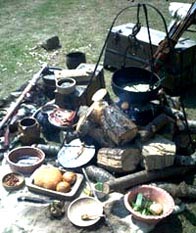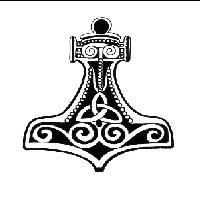The Blot
Copyright (C) 1991, 1992 Lewis Stead
Edited by Scott Mohnkern, 2007.
The Blot is the most common ritual within Asatru. In its simplest form a blot is making a sacrifice to the Gods. In the old days this was done by feasting on an animal consecrated to the Gods and then slaughtered. (The word blot itself is related to the Norse words for “blood” and “sacrifice.”) As we are no longer farmers and our needs are simpler today, the most common blot is an offering of mead or other alcoholic beverage to the deities.
Many modern folk will be suspicious of a ritual such as this. Rituals such as the blot have been falsely interpreted by post-Pagan sources in order to denigrate the ritual or trivialize it. The most common myth about ritual sacrifice is that one is buying off a deity e.g. one throws a virgin into the Volcano so it won’t erupt. Nothing could be further from the truth. In Asatru it is believed that we are not only the worshippers of the Gods but that we are physically related to them. The Eddas tell of a God, Rig, who went to various farmsteads and fathered the human race so we are physically kin to the Gods. On a more esoteric level, humankind is gifted with “ond” or the gift of ecstasy. Ond is a force that is of the Gods. It is everything that makes humans different from the other creatures of the world. As creatures with this gift, we are immediately connected to the Gods, we are part of their tribe, their kin. Thus we are not simply buying off the Gods by offering them something that they want, but we are sharing with the Gods something that we all take joy in. Sharing and gift giving was an incredibly important part of Norse culture (and of most ancient cultures) and had magical significance. Giving a gift was a sign of friendship, kinship, and connection. By sharing a blot with the Gods we reaffirm our connection to them and thus reawaken their powers within us and their watchfulness over our world.
A blot can be a simple affair where a horn of mead is consecrated to the Gods and then poured as a libation, or it can be a part of a larger ritual. A good comparison is the Catholic Mass which may be part of a regular service or special event such as a wedding or funeral, or it may be done as a purely magical-religious practice without any sermon, hymns, or other trappings.
The blot consists of three parts, the hallowing or consecrating of the offering, the sharing of the offering, and the libation. Each of these is equally important. The only tools required are mead, beer or juice, a horn or chalice, a sprig of evergreen used to sprinkle the mead, and a ceremonial bowl known as a Hlautbowl into which the initial libation will be made.
The blot begins with the consecration of the offering. The Gothi (Priest) or Gythia (Priestess) officiating at the blot invokes the God or Goddess being honored. This is usually accomplished by a spoken declaration with ones arms being held above ones head in a Y shape, in imitation of the rune elhaz. This posture is used for most invocations and prayers throughout Asatru. After the spoken invocation an appropriate rune or other symbol of the God or Goddess may be drawn in the air with the finger or with the staff. Once the God is invoked, the Gothi takes up the horn. His assistant pours mead from the bottle into the horn. The Gothi then traces the hammer sign (an upside down T) over the horn as a blessing and holds it above his head offering it to the Gods. He then speaks a request that the God or Goddess bless the offering and accept it as a sacrifice. At least one will feel the presence of the deity; at best one will be able to feel in some inner way the God taking of the mead and drinking it.
The mead is now not only blessed with divine power but has passed the lips of the God or Goddess. The Gothi then takes a drink of the horn and it is passed around the gathered folk. Although it sounds like a very simple thing, it can be a very powerful experience. At this point the mead is no longer simply a drink but is imbued with the blessing and power of the God or Goddess being honored. When one drinks, one is taking that power into ones self. After the horn has made the rounds once, the Gothi again drinks from the horn and then empties the remainder into the hlautbowl. The Gothi then takes up the evergreen sprig and his assistant the hlautbowl and the Gothi sprinkles the mead around the circle or temple or onto the altar. If there are a great number of the folk gathered, one may wish to drop the drinking and merely sprinkle the various folk with the mead as a way of sharing it. In a small group one might merely drink as the blessing.
When this is done the Hlautbowl is taken by the Gothi and poured out onto the ground. This is done as an offering not only to the God invoked at the blot, but it is also traditional to remember the Earth Mother at this time, since it is being poured onto her ground. Many invocations mention the God, Goddess, or spirit being sacrificed to, and then Mother Earth, as in the Sigrdrifa Prayer “Hail to the Gods and to the Goddesses as well; Hail Earth that gives to all men.” (Sigrdrifumal 3) With this action, the blot is ended.
Obviously this is a very sparse ritual and if performed alone could be completed in only a few minutes. This is as it should be, for blots are often poured not because it is a time of gathering or festivity for the folk, but because the blot must be poured in honor or petition of a God or Goddess on their holiday or some other important occasion. For example, a father tending his sick child might pour a blot to Eir the Goddess of healing. Obviously he doesn’t have time to waste on the “trappings” of ritual. The intent is to make an offering to the Goddess as quickly as possible. At some times a full celebration might not be made of a holiday because of a persons hectic schedule, but at the least a blot should be made to mark the occasion. However, in most cases a blot will at least be accompanied by a statement of intent at the beginning and some sort of conclusion at the end. It might also be interspersed with or done at the conclusion of ritual theater or magic. Our kindred, for example, begins the ritual with a chant of “Odin, Vili, Ve” which connects us to the Gods of creation. Between the invocation of the God or Goddess and the actual Blot we usually add a meditation or something else which acts as a focus of the ritual. Once, for example, we made mead in the middle of a ritual to Aegir. As part of our blot we also pass the horn three times. The first time around is a taking in of the power of the charged mead and all offer a toast to the God(s) of the occasion. The second and third rounds are open to toasts to other Gods, toasts to the kindred, the hosts, to pledges, boasting and anything else on wishes to say. It is essentially a “mini sumble” in the middle of our blot. Always of course, we remember the purpose of our ritual. We would never toast one of the Jotnar during a ritual to Thor for example. We have also added a few steps at the end which are a private affirmation of our groups kinship with each other and with the Gods.
 The Importance of the Feast in Asatru
The Importance of the Feast in Asatru
 What is a Hammer Rite?
What is a Hammer Rite?